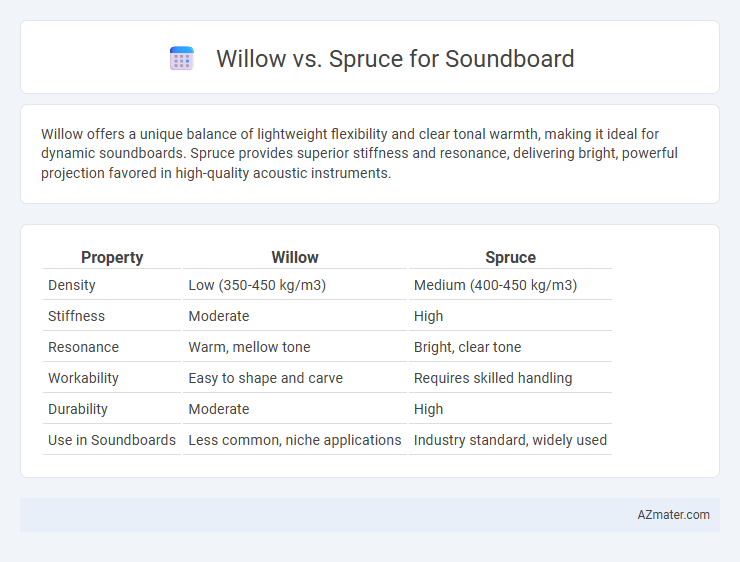Willow offers a unique balance of lightweight flexibility and clear tonal warmth, making it ideal for dynamic soundboards. Spruce provides superior stiffness and resonance, delivering bright, powerful projection favored in high-quality acoustic instruments.
Table of Comparison
| Property | Willow | Spruce |
|---|---|---|
| Density | Low (350-450 kg/m3) | Medium (400-450 kg/m3) |
| Stiffness | Moderate | High |
| Resonance | Warm, mellow tone | Bright, clear tone |
| Workability | Easy to shape and carve | Requires skilled handling |
| Durability | Moderate | High |
| Use in Soundboards | Less common, niche applications | Industry standard, widely used |
Willow vs Spruce: An Overview for Soundboards
Willow and spruce are both popular tonewoods used in soundboards, with spruce offering a bright, clear, and projecting sound favored in many acoustic guitars and violin tops due to its stiffness-to-weight ratio. Willow, though less common, provides a softer, warmer tone with a quicker response, ideal for folk instruments and hand drums where a mellow sound is desired. The choice between willow and spruce depends on the desired tonal qualities and instrument type, with spruce generally preferred for its dynamic range and willow for its unique warmth and resonance.
Wood Density and Its Impact on Sound Quality
Willow, with its lower wood density compared to spruce, produces a softer, warmer tone ideal for certain acoustic applications requiring enhanced midrange frequencies. Spruce's higher density contributes to greater stiffness and resilience, delivering a brighter, more projecting sound with excellent dynamic range and sustain. Choosing between willow and spruce soundboards depends on the desired tonal character and the instrument's acoustic requirements, as wood density directly affects soundboard vibration and resonance.
Grain Structure: How Willow and Spruce Differ
Willow and spruce exhibit distinct grain structures that significantly impact their soundboard performance. Spruce features a straight, tight grain pattern that allows for uniform vibration and superior resonance, making it a preferred choice in high-quality acoustic instruments. Willow, with its more irregular and open grain, offers a warmer, less focused tone but may lack the consistent strength and stiffness found in spruce soundboards.
Resonance and Tonal Characteristics Compared
Willow and spruce are popular tonewood choices for soundboards, each offering distinct resonance and tonal qualities. Willow produces a warm, woody resonance with a softer attack, emphasizing midrange frequencies that enhance expressive playing, while spruce delivers a brighter, more articulate tone with strong dynamic range and clear projection due to its lightweight, stiff structure. The denser grain of spruce provides superior resonance sustain, whereas willow's flexible fibers result in a mellower sound suited for intimate acoustic environments.
Durability and Stability in Musical Instruments
Willow and spruce both serve as popular soundboard materials in musical instruments, with spruce known for its superior stiffness-to-weight ratio, providing excellent resonance and projection while maintaining durability. Willow, although less common, offers decent stability and a unique tonal character but is typically less resilient to environmental changes compared to spruce. Spruce's consistent cellular structure contributes to long-term stability and resistance to warping, making it the preferred choice for professional-grade soundboards.
Workability and Luthier Preferences
Willow offers excellent workability with its lightweight and easy-to-carve properties, favored by luthiers for creating detailed soundboard braces and intricate designs. Spruce, particularly Sitka and Engelmann varieties, remains the preferred choice for soundboards due to its superior stiffness-to-weight ratio, providing optimal resonance and sustain. Luthiers often balance the ease of shaping willow with the tonal superiority of spruce, selecting materials based on the desired instrument voice and construction efficiency.
Cost and Availability of Willow and Spruce
Spruce remains the most widely available and cost-effective option for soundboards, typically priced affordably due to its abundant supply and strong acoustic properties. Willow, although prized for its unique tonal qualities, is less common and often commands higher prices because of limited availability and specialized sourcing requirements. Musicians and luthiers must weigh the cost-benefit ratio, as spruce offers consistent accessibility and value, while willow might increase production expenses and supply chain complexity.
Traditional Use in Soundboard Construction
Willow and Spruce are both prized in traditional soundboard construction, with Spruce being the preferred material for its superior strength-to-weight ratio and excellent resonance qualities, particularly Sitka Spruce known for its tonal clarity and dynamic range. Willow, while less common, is occasionally used for its lightweight properties and unique acoustic warmth, although it generally lacks the stiffness and responsiveness seen in Spruce. Historically, Spruce's consistent grain and dense fibers have made it the dominant choice for high-quality instruments like guitars and violins, ensuring soundboards that deliver both projection and tonal complexity.
Best Applications: Instruments Suited for Each Wood
Willow soundboards excel in producing warm, mellow tones ideal for acoustic guitars and violins, where a softer, more resonant sound is desired. Spruce, favored for its strength-to-weight ratio and bright, clear projection, is perfect for instruments like violins, guitars, and pianos that require a vibrant, articulate sound. Both woods are prized in lutherie, but spruce's stiffness provides superior dynamic range and responsiveness, making it the top choice for professional-grade stringed instruments.
Choosing the Right Soundboard: Willow or Spruce?
Willow often provides a warmer, more mellow tone with excellent midrange clarity, making it ideal for folk or blues-style instruments, while spruce delivers a bright, responsive sound with strong projection favored in classical and bluegrass settings. Spruce's high strength-to-weight ratio supports greater dynamic range and articulation, whereas willow's slightly denser grain offers enhanced sustain and complexity. Selecting between willow and spruce soundboards depends on the desired tonal character and musical genre, with spruce favored for crisp attack and willow chosen for a rich, rounded sound profile.

Infographic: Willow vs Spruce for Soundboard
 azmater.com
azmater.com